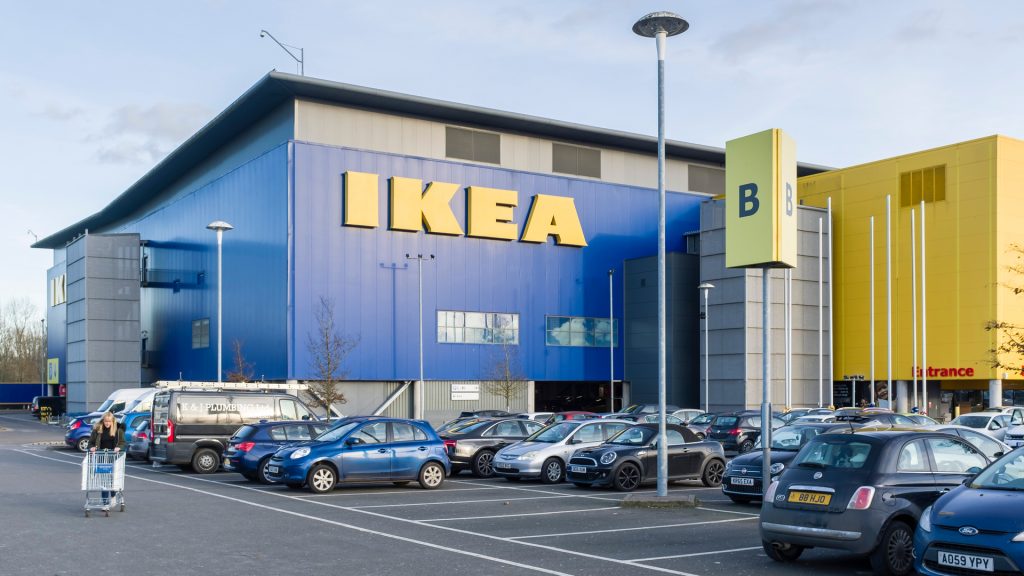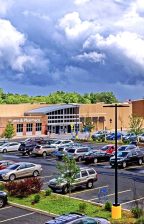As the market analyzes and market reports show, ‘shopping centers’ is currently the most dynamically developing sector in the commercial business. The current supply of retail parks in Poland is estimated at approx. 1.97 million m2 of the gross leasable area (GLA). Above all, the customers of these centers appreciate the possibility of doing a quick shopping in a comfortable way, in well-known chainsstores and in the vicinity of their home. The extraordinary conditions in which the business entities found themselves in the previous year, as a result of the pandemic, has strengthened the position of the retail parks on the background of other forms of doing business.
WHAT AFFECTS THE CHOICE OF THE SHOPPING CENTRES
A study commissioned by Procontent Communication agency shows that the most important factors determining the choice of the shopping center among the Poles are: the location (65%), special offers (62%), and the availability of favorite brands (48%). Auchan, Carrefour and Tesco chains are perceived as positive, in terms of the so-called Corporate Image, by 16% of the respondents. Does this allow us to find out what brands the Poles trust most? Well, yes. As indicated in the Report “Retail chains as seen by the Poles” – at least for the participants of the survey – the three most trustworthy brands of retail chains are Biedonka (65%), Lidl (48%) and Kaufland (35%). Interestingly, Biedronka stores, owned by the Portuguese group Jeronimo Martins have remained the most visited ones for several years. The portfolio of this Portuguese company includes not only Biedronka stores, but also Hebe and Apteka Na Zdrowie outlets. The high position in the customer confidence survey confirms that Biedronka has chosen the right strategy.
RETAIL PARKS SECTOR
The first retail parks appeared in Poland in the early 90s. Since then, the retail market has been constantly evolving. The expansion of traditional retail parks has been followed by the development of another type – the ‘convenience’ centers. The main drivers for the development of the retail market in Poland are the consumers demand for quick and convenient shopping. The retail park sector remains quite diverse, despite sharing many common features. What has recently become the most noticeable trend though is the gradual polarization of the market – dividing into large shopping centers, with a wide entertainment and food court offer, and small convenience facilities. COVID-19 has significantly weakened the position of the largest shopping centres and large size facilities, giving a competitive advantage to the facilities of the area of less than 2,000 GLA.
Retail parks typically fall into the following categories:
- Regional retail parks (GLA equal or more than 10.000m2)
- Traditional retail parks (GLA from 5,000 m2 to 9,999 m2)
- Retail convenience. (GLA less than 5,000 m2)
INVESTMENT MARKET
In recent years, following the dynamic increase in supply of the retail parks, there has been a high rise in the level of activity in the retail investment sector in Poland, reaching the record high 2.497 million EUR in 2018. – Currently, the trend shows an increase in the number of transactions. In 2020, 23 out of 35 transactions dealt with retail parks and convenience properties. The largest one was the sale of the “Tyrion” portfolio, comprising 5 convenience shopping centers. It is also worth to mention the purchase of two MMG Centers by DRFG and OBI stores located in Gdańsk and Łódź by MARR Holdings. It was the first acquisition by a South African real estate investor in Poland, foreshowing their expansion in Central and Eastern Europe. Both OBI supermarkets, being the subject of the transaction, have a good reputation on the local markets and offer a total of 18,141 m2of leasable space. The buildings have recently been modernized – says Agata Karolina Lasota, CEO of LBC Invest. In 2020, Origami acquired two Tesco facilities. March this year was the time of the largest transaction in the retail segment. EPP company has finalized the purchase of the last tranche of the M1 portfolio, consisting of four retail parks – in Olsztyn, Opole, Kielce and Tychy – purchased for 106 million EUR. The total leasable area of the property is 110.000 m2.
COVID-19 and restrictions introduced in consequence thereof have disrupted the sector, resulting in many foreign investors deciding to wait for the outcome of the events. However, Polish investors have rapidly become much more interested in certain groups of products – which include, in particular, convenience centers, retail parks and free-standing grocery stores.
Currently, the investors are primarily interested in convenience centers, i.e. facilities up to 5,000 GLA. The preferred choice most often falls on the smallest commercial formats, providing services for the nearest neighborhood with an area of up to 2.000 GLA. These centres have often limited number of products on offer and focus on satisfying the basic needs. The facilities are usually located at the main city roads or in densely populated areas. – From my experience, collected during many meetings and talks with investors, I suppose that the interest in retail parks, especially in facilities with a food operator, will only grow bigger. Some investors have started to specialize exclusively in this format. The capitalization rates of well-commercialized retail park space usually remain in the range between 7% and 9%. In large urban agglomerations, they may reach the value below 7%. – Retail parks, offered in portfolios, are the most attractive forms for investors – reports Agata Karolina Lasota.
THE MOST POPULAR BRANDS IN THE TRADITIONAL RETAIL PARKS AND RETAIL CONVENIENCE, ACCORDING TO THE NUMBER OF OUTLETS
- VALUE RETAILERS Pepco, Action, TEDi, Dealiz, KiK
- STORES WITH SPECIAL RANGE OF PRODUCTS: Martes Sport, Smyk, Empik, Jysk
- BEAUTY SUPPLY STORES: Rossman, Hebe
- ELECTRONICS: Media Expert, RTV Euro AGD, NEONET
- FOODSTUFF: ALDI, Biedronka, Stokrotka, Lidl, Carrefour
- FOOTWEAR: CCC, Deichmann
- FASHION

RETAIL PARK IKEA
THE STRUCTURE OF THE LESSEE AND THE RENT
In Poland, retail parks attract various groups of lessees. Traditional retail parks and convenience centres meet the basic needs of consumers, living in the vicinity of these. Because of that the standard structure in a retail park involves: a grocery store, a beauty supply and a multi-branch discount store. The tenants are usually: foodstuff chains (Lidl or Biedronka); beauty supply stores (Rossman, Hebe); post office, newsagents, pet shops, pharmacies and laundries. The range of products of regional retail parks is mostly focused on consumer electronics, interior design equipment and sports equipment. Different lessees expect different conditions in relation to space.
Retail parks in Poland are a much more attractive alternative to shopping centers, especially in the period of pandemic market turmoil on the real estate market. Rents and service charges are lower than in shopping centers. Prime rents in the best retail park facilities are currently around EUR 8-12 / m2, with service charges of around EUR 1.5-2 / m2. And how much do you have to pay for rent in shopping centers? Around 40-60 Euro / m2 in regional cities. Prime rents in Warsaw may be even more than 100% higher, i.e. EUR 125 / m2. It should be emphasized here that trade in large-size facilities has significantly weakened the sales position of Polish high streets, and in the context of the development of e-commerce, premises in a shopping center no longer guarantee a profit. The most expensive high street in Poland is Nowy Świat in Warsaw. Floriańska Street in Kraków and Chmielna Street in Warsaw are also often mentioned in that matter.
The “click & collect” service in retail parks gives the business partners the convenience of using parcel machines or other self-service devices. What is worth mentioning is that in case of commercial premises in retail parks, with separate entrances to the premises, it is possible to achieve flexibility in opening and closing hours of individual retail outlets. Another advantage of retail parks is also the free car park.
Both in retail parks and shopping centers, the term of the lease agreement is at a similar level. These are usually 3.5 or 7-year contracts, rarely shorter (2-3 years). The annual indexation of rent is carried out according to the increase in consumer prices for the EURO zone (the so-called HICP). The lease agreements are usually secured with a bank guarantee or a cash deposit in the amount including the 3-month base rent, as well as maintenance and marketing fees. To attract the potential lessees, there are often incentives on offer, including co-financing the costs of arranging commercial space, rent-free periods and rolling rents.
ADVANTAGES OF RETAIL PARKS
From both the lessee and investor point of view, retail parks proved to be resistant to the market turmoil caused by the COVID-19 pandemic. Since the beginning thereof, customers visited these retail parks much more often than shopping centers. The lack of restrictions during the “lockdown” periods on the business conducted by the lessees of the retail parks allows for their efficient operation. What is more, the simple structure (no underground parking lots, escalators and common parts) is also an advantage of the retail parks, which results in low operating and construction costs. Their local nature is seen as a positive feature both by the investors and the lessees, as it helps focus on the consumers living in the neighborhood, thus avoiding a lot of competition with other retail properties. An attractive discount offer allows you to save money, while the versatility – to be more time efficient.
This entry was prepared by the International Investor and Business Assistance Center – LBC Invest
LBC Invest is an experienced advisor in stable and profitable investments in the field of commercial real estate, perfectly oriented in the ins and outs and the potential of the local markets and the purchasing needs of local markets investors. Our clients are pleased to see that the return on investment in the area of commercial real estate comes within a significantly shorter time than in case of residential real estate. We would like to encourage you to familiarize with our off-market offer for retail parks and commercial premises throughout whole Poland.









